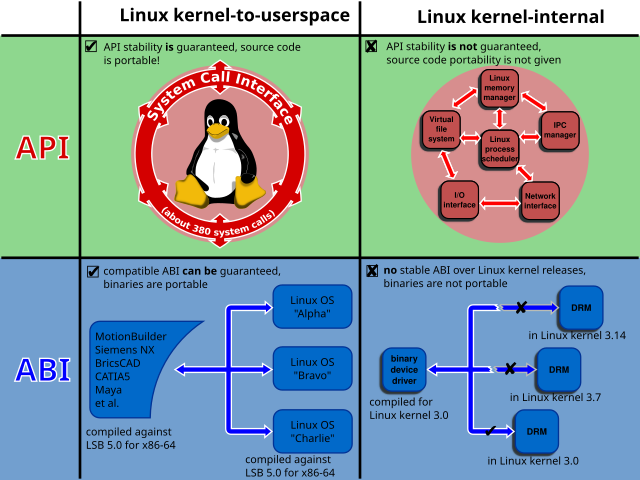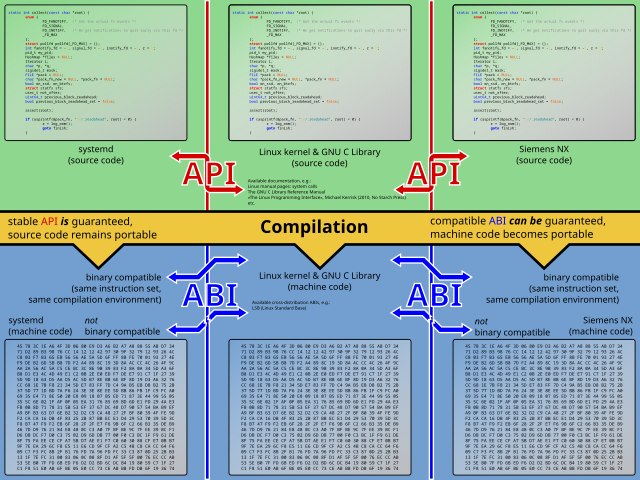Top Qs
Timeline
Chat
Perspective
Application binary interface
Interface to software defined in terms of in-process, machine code access From Wikipedia, the free encyclopedia
Remove ads
An application binary interface (ABI) is an interface exposed by software that is defined for in-process machine code access. Often, the exposing software is a library, and the consumer is a program.


An ABI is at a relatively low level of abstraction. Interface compatibility depends on the target hardware and the software build toolchain. In contrast, an application programming interface (API) defines access in source code, which is a relatively high-level, hardware-independent, and human-readable format. An API defines an interface at the source code level, before compilation, whereas an ABI defines an interface to compiled code.
API compatibility is generally the concern for system design and of the toolchain. However, a programmer may have to deal with an ABI directly when writing a program in multiple languages or when using multiple compilers for the same language.
A complete ABI enables a program that supports an ABI to run without modification on multiple operating systems that provide the ABI. The target system must provide any required libraries (that implement the ABI), and there may be other prerequisites.
Remove ads
Description
Interface aspects covered by an ABI include:
- Processor instruction set, with details like register file structure, memory access types, etc.
- Size, layout, and alignment of basic data types that the processor can directly access
- Calling convention, which controls how the arguments of functions are passed, and return values retrieved; for example, it controls the following:
- How the call stack is organized
- Whether all parameters are passed on the call stack, or some are passed in registers
- Which registers are used for which function parameters
- Whether the first function parameter passed on the call stack is pushed first or last
- Whether the caller or callee is responsible for cleaning up the call stack after the function call
- Name mangling[1]
- Exception propagation[2]
- How an application should make system calls to the operating system, and if the ABI specifies direct system calls rather than procedure calls to system call stubs, the system call numbers
- In the case of a complete operating system ABI, the binary format of object files, program libraries, etc.
ABIs include the Intel Binary Compatibility Standard (iBCS)[3] and the System V Release 4 ABIs for various instruction sets.
Remove ads
Embedded ABI
Summarize
Perspective
An embedded ABI (EABI), used on an embedded operating system, specifies aspects such as file formats, data types, register usage, stack frame organization, and function parameter passing of an embedded software program.
Each compiler and assembler that supports an EABI creates object code that is compatible with code generated by other such compilers and assemblers. This allows developers to link libraries generated by one compiler with object code generated by another.
Typically, an EABI is optimized for performance for the limited resources of the target embedded system. Therefore, an EABI may omit abstractions between kernel and user space typically found in desktop operating systems. For example, dynamic linking may be avoided to allow smaller executables and faster loading, fixed register usage allows more compact stacks and kernel calls, and running the application in privileged mode allows direct access to custom hardware operation without the indirection of calling a device driver.[4] The choice of EABI can affect performance.[5][6]
Widely used EABIs include the PowerPC,[4] Arm,[7] and MIPS EABIs.[8] Specific software implementations like the C library may impose additional limitations to form more concrete ABIs; one example is the GNU OABI and EABI for ARM, both of which are subsets of the ARM EABI.[9]
Remove ads
See also
- Binary-code compatibility – Ability of a computer system to run the same code as another computer system
- Bytecode – Form of instruction set designed to be run by a software interpreter
- Comparison of application virtualization software
- Debug symbol – Type of identifier in computer science
- Foreign function interface – Interface to call functions from other programming languages
- Language binding – Software library that allows using another library coded in another programming language
- Native (computing) – Software that operates directly in a given context
- Opaque pointer – Opaque data type which stores a memory address
- PowerOpen Environment – Open standard by AIM alliance
- Symbol table – Data structure used by a language translator such as a compiler or interpreter
- SWIG – Open-source programming tool
- Visual C++ Compatibility
References
External links
Wikiwand - on
Seamless Wikipedia browsing. On steroids.
Remove ads
